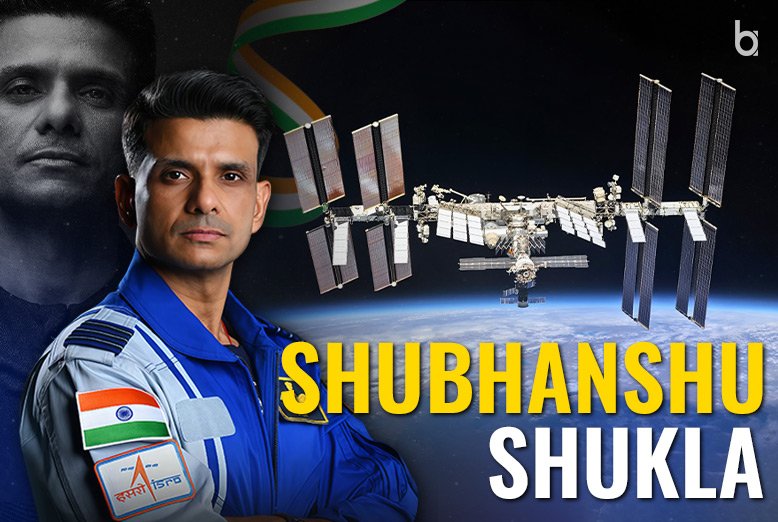June 26, 2025. India didn’t just watch the sky. It entered it. Owned it. Shubhanshu Shukla — not a name from textbooks yet, but now etched into space history — became the first Indian to set foot on the International Space Station. No Bollywood drama. No background hype. Just one man, one dream, and 28 hours later — one historic step into the ISS. He didn’t just go to space. He took India with him.
A Group Captain in the Indian Air Force, a fighter pilot, and now a mission pilot on Axiom Mission 4 (Ax-4) — Shukla’s story is proof that the impossible is just a delayed reality. This blog isn’t about space facts. It’s about a movement. A fire. From Gaganyaan to the Bharatiya Antariksha Station, he’s not just part of the mission — he’s building the roadmap.
Get ready to meet the man who turned orbit into India’s new address. This isn’t a journey. This is a launch. And now, without wasting any single moment, let’s jump into the topic straight up.
Who is Shubhanshu Shukla? A Glimpse into His Background
Shubhanshu Shukla is a name that now echoes in the skies — and even in space.
Born on October 10, 1985, in Lucknow, Uttar Pradesh, he grew up in a grounded, middle-class Indian household. He is the youngest of three children. His father, Shambhu Dayal Shukla, worked as a government officer, and his mother, Asha Shukla, stayed at home to raise the family.
From a young age, he showed a deep interest in science and systems. He studied at City Montessori School (CMS), Aliganj Campus — one of Lucknow’s most recognized schools. This is where his interest in space and flight quietly began to grow.
His strong academic foundation in science began early. He pursued a Bachelor’s degree in Computer Science through India’s military education route. Later, he advanced further with an MTech in Aerospace Engineering from the respected Indian Institute of Science (IISc). This sharpened his skills in solving complex challenges related to flight and space.
On the personal front, Shubhanshu is married to his childhood friend, Dr. Kamna Mishra, a dentist. Together, they have a son. These small yet personal details reflect the human side of a man trained for space.
When people look up the Shubhanshu Shukla biography, they don’t just find dates. They find a story — one that begins in a city lane of Lucknow and stretches all the way to the stars.
From Fighter Pilot to Astronaut
In 2003, Shubhanshu Shukla began his military journey by enrolling in India’s top defence institution. Just three years later, in June 2006, he was commissioned into the Indian Air Force (IAF) as a fighter pilot.
His early years in service were marked by discipline and courage. He became a combat leader and also trained as a test pilot — a role that demands deep technical knowledge and trust. These roles require not only flying skills but also the ability to manage extreme conditions.
Over the years, he logged more than 2,000 hours of flight time. He flew some of India’s most advanced fighter jets, including the Su-30 MKI and MiG-21. Handling these jets is not easy, but Shubhanshu made it routine.
This flight experience, combined with his academic background in aerospace, made him a top contender for something even bigger. He was selected for ISRO’s Gaganyaan program, India’s mission to send humans into space.
This transition from flying in Earth’s atmosphere to preparing for space travel shows how far he has come. It also shows India’s growing faith in its own experts.
When you search for Shubhanshu Shukla’s career, you’ll find much more than a resume. You’ll see a timeline that connects every takeoff to his greatest launch, the one that took him beyond our planet.
Historic Achievement: The International Space Station Mission (Ax-4)
Becoming the first Indian to visit the International Space Station (ISS) is no small feat. But for Shubhanshu Shukla, it’s not just a record. It’s a responsibility — to science, to his country, and to the future of human spaceflight.
Mission Role and Launch Timeline
In 2025, Shubhanshu Shukla was chosen as the mission pilot for Axiom Mission 4 (Ax-4). This international expedition was aimed at deep scientific research aboard the ISS. His role placed him at the center of a mission that involved top global astronauts.
The launch took place on Wednesday, June 25, 2025. Shubhanshu piloted the Crew Dragon C213 spacecraft. After a 28-hour journey, the vehicle successfully docked with the ISS on June 26, 2025.
With this, he became the 634th astronaut in the world to travel to space — and importantly, the first Indian ever to set foot on the ISS.
Life Aboard the ISS
Upon arrival, Shubhanshu and his fellow astronauts were welcomed by the crew of Expedition 73. In a moment filled with emotion, he received his astronaut pin — a symbol of entry into the spacefaring community.
His first few hours in microgravity weren’t easy. He described feeling “not well” and mentioned dizziness. But within a short time, he adjusted and described the experience as “indescribable.” This honest moment adds real-life depth to his journey, highlighting not just his strength but also his vulnerability.
Scientific Objectives and India’s Role
The Ax-4 mission involves 60 scientific studies from 31 countries. These studies range from biology and space medicine to materials science and environmental monitoring.
Shubhanshu’s work is especially important to India’s growing space goals. Onboard, he’s conducting key Indian-led experiments — including a study on growing Indian superfoods like moong and methi in zero gravity. This experiment looks at how seeds behave in microgravity and could unlock new treatments for diabetes.
Additionally, Shubhanshu will interact with school students and ISRO scientists through live calls and messages from space. This adds a human touch to his scientific mission and inspires future scientists back home.
Why This Mission Matters
This historic spaceflight isn’t just about breaking records. It plays a strategic role in the Gaganyaan program, where India aims to send its own astronauts into space by 2027. Shubhanshu’s success builds confidence in ISRO’s capabilities, strengthens India’s global position, and contributes directly to the achievements of ISRO in human spaceflight.
His experiments could lay the foundation for India’s future space station plans and even long-term missions to the Moon and Mars.
Shubhanshu Shukla’s Integral Role in India’s Gaganyaan Program
Shubhanshu Shukla is not just a space traveler. He is a crucial part of India’s bold vision for space.
As an astronaut at ISRO, Shubhanshu has been selected for future human space missions under the ambitious Gaganyaan program. This program aims to send Indian astronauts into space aboard a made-in-India spacecraft. For his current mission, Ax-04, he was selected as the prime crew member, while Prashanth B. Nair was named as the backup. This speaks volumes about the trust placed in his experience.
His current spaceflight to the International Space Station (ISS) isn’t just about making history. It serves a much deeper purpose. The mission acts as a testing ground for India’s upcoming manned spaceflight in 2027. Every experiment he performs, especially those on seed development in microgravity, helps gather critical data for the Gaganyaan mission.
By representing India aboard the ISS, Shubhanshu is helping build global confidence in ISRO’s human spaceflight abilities. This also makes him a bridge between India’s present efforts and its future space goals.
Looking ahead, India plans to build its own Bharatiya Antariksha Station by 2035 and aims to send the first Indian to the Moon by 2040. Shubhanshu’s role in this journey places him at the heart of India’s growing space leadership.
When we talk about the space program in India, names like Shubhanshu Shukla remind us that the future is no longer a dream. It’s a plan — and it’s already underway.
Recent News and Public Engagement
Shubhanshu Shukla’s journey has turned into a series of headlines — and for good reason. His mission is not just history in the making; it’s a story that’s still unfolding.
Here are the key highlights from his time in space:
- First Indian to enter the International Space Station (ISS), marking a milestone in India’s space legacy.
- Made his first live call from space, describing the experience as “indescribable.”
- Shared how it felt to float for the first time, and admitted to feeling “not well” during his initial hours, an honest look into space adaptation.
- Revealed that astronauts must tie their sleeping bags to avoid drifting while sleeping, a small but fascinating detail.
- Welcomed warmly by the Expedition 73 crew and received his official astronaut pin.
- Announced live interaction plans with ISRO scientists and school students, bringing the mission back to the classroom.
These updates turned into daily talking points across newsrooms, schools, and homes. His mission is not just science; it’s storytelling that connects.
Today, when you search for Shubhanshu Shukla news, you find more than updates. You see excitement. You see dreams. And most of all, you see inspiration lighting up a new generation of thinkers and explorers.
Key Takeaways
Shubhanshu Shukla didn’t wake up one day in space. He walked it through dust, discipline, and decisions that most avoid. What made this mission historic wasn’t just reaching the International Space Station — it was proving that it’s possible, even when the path seems out of reach.
He wasn’t born with stars under his name. He earned every inch of that orbit.
That’s the real story.
The takeaway isn’t about space travel. It’s about breaking inertia. It’s about showing up, staying consistent, and preparing long before the opportunity arrives. Not every dream requires a rocket — some just need a restart. The world may never applaud quietly-built dreams, but results always speak from the loudest places, even space.
The world doesn’t need another Shubhanshu. It needs the first of many who dare like him. Every classroom, street, cockpit, or quiet desk holds a launchpad. This story simply reminds what happens when belief, grit, and vision align.
For those waiting for perfect timing, takeoff never happens by waiting. Fuel it. Prepare. And when the call comes, rise with fire.







